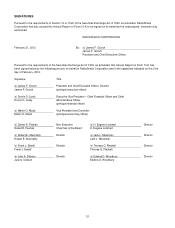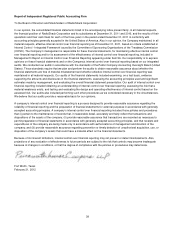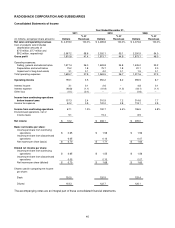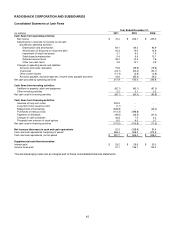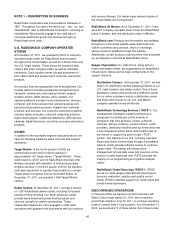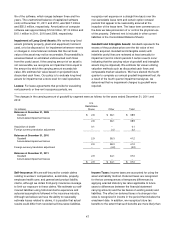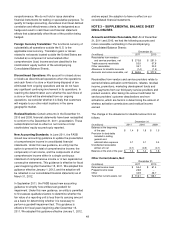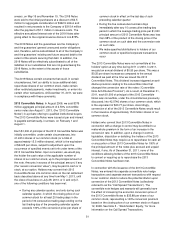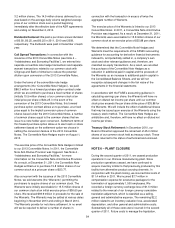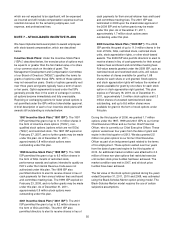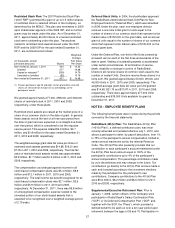Radio Shack 2011 Annual Report Download - page 55
Download and view the complete annual report
Please find page 55 of the 2011 Radio Shack annual report below. You can navigate through the pages in the report by either clicking on the pages listed below, or by using the keyword search tool below to find specific information within the annual report.
47
life of the software, which ranges between three and five
years. The unamortized balance of capitalized software
costs at December 31, 2011 and 2010, was $42.7 million
and $55.3 million, respectively. Amortization of computer
software was approximately $12.6 million, $11.9 million and
$15.1 million in 2011, 2010 and 2009, respectively.
Impairment of Long-Lived Assets: We review long-lived
assets (primarily property, plant and equipment) held and
used, or to be disposed of, for impairment whenever events
or changes in circumstances indicate that the net book
value of the asset may not be recoverable. Recoverability is
assessed based on estimated undiscounted cash flows
from the useful asset. If the carrying amount of an asset is
not recoverable, we recognize an impairment loss equal to
the amount by which the carrying amount exceeds fair
value. We estimate fair value based on projected future
discounted cash flows. Our policy is to evaluate long-lived
assets for impairment at a store level for retail operations.
Leases: For lease agreements that provide for escalating
rent payments or free-rent occupancy periods, we
recognize rent expense on a straight-line basis over the
non-cancelable lease term and certain option renewal
periods that appear to be reasonably assured at the
inception of the lease term. The lease term commences on
the date we take possession of or control the physical use
of the property. Deferred rent is included in other current
liabilities in the Consolidated Balance Sheets.
Goodwill and Intangible Assets: Goodwill represents the
excess of the purchase price over the fair value of net
assets acquired. Goodwill and intangible assets with
indefinite useful lives are reviewed at least annually for
impairment (and in interim periods if certain events occur
indicating that the carrying value of goodwill and intangible
assets may be impaired). We estimate fair values utilizing
valuation methods such as discounted cash flows and
comparable market valuations. We have elected the fourth
quarter to complete our annual goodwill impairment test. As
a result of the fourth quarter impairment analyses, we
determined that no impairment charges to goodwill were
required.
The changes in the carrying amount of goodwill by segment were as follows for the years ended December 31, 2011 and
2010:
(In millions)
U.S.
RadioShack
Stores
Other
Total
Balances at December 31, 2009
Goodwill $ 2.8 $ 36.1 $ 38.9
Accumulated impairment losses -- -- --
2.8 36.1 38.9
Acquisition of dealer
0.1
--
0.1
Foreign currency translation adjustment -- 2.2 2.2
Balances at December 31, 2010
Goodwill 2.9 38.3 41.2
Accumulated impairment losses -- -- --
2.9 38.3 41.2
Foreign currency translation adjustment -- (4.2) (4.2)
Balances at December 31, 2011
Goodwill 2.9 34.1 37.0
Accumulated impairment losses -- -- --
$ 2.9 $ 34.1 $ 37.0
Self-Insurance: We are self-insured for certain claims
relating to workers’ compensation, automobile, property,
employee health care, and general and product liability
claims, although we obtain third-party insurance coverage
to limit our exposure to these claims. We estimate our self-
insured liabilities using historical claims experience and
actuarial assumptions followed in the insurance industry.
Although we believe we have the ability to reasonably
estimate losses related to claims, it is possible that actual
results could differ from recorded self-insurance liabilities.
Income Taxes: Income taxes are accounted for using the
asset and liability method. Deferred taxes are recognized
for the tax consequences of temporary differences by
applying enacted statutory tax rates applicable to future
years to differences between the financial statement
carrying amounts and the tax bases of existing assets and
liabilities. The effect on deferred taxes of a change in tax
rates is recognized in income in the period that includes the
enactment date. In addition, we recognize future tax
benefits to the extent that such benefits are more likely than


